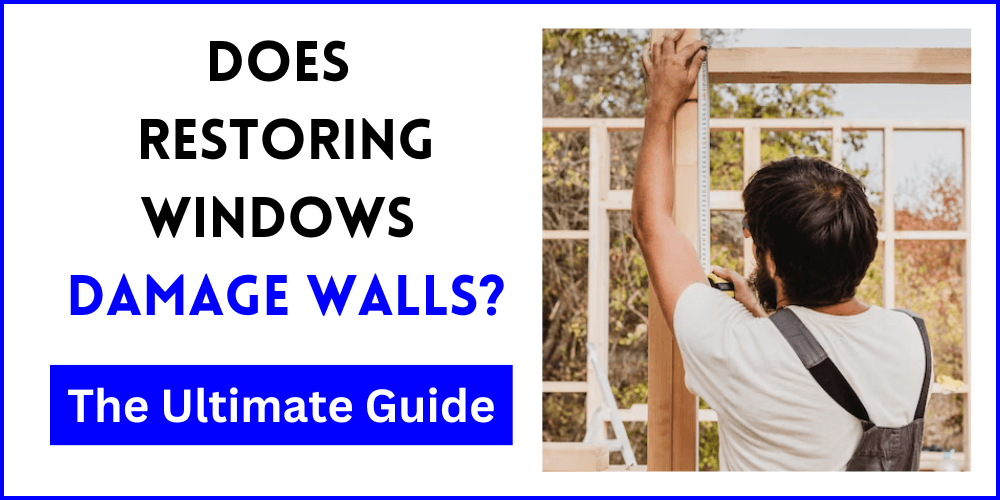
Restoring windows can be a crucial step in preserving the charm and functionality of older homes. However, homeowners often have concerns about whether the restoration process can inadvertently cause damage to their walls. In this comprehensive guide, we will delve into the world of window restoration to answer the burning question: Does restoring windows damage walls?
Does Restoring Windows Damage Walls?
Before we dive into the conceivable impact on walls, it’s important to understand does restoring windows damage walls. Window restoration is the procedure of repairing and refurbishing older windows to bring them back to their original shape or improve their functionality. This can involve tasks like repairing or replacing damaged glass, weatherstripping, hardware, and even repainting.
The Restoration Process typically involves the following steps:
Assessment: A thorough inspection is carried out to identify the extent of damage and the work required.
Repairs: Any damaged components, such as broken glass panes or rotted wood, are repaired or replaced.
Weatherproofing: Windows are resealed and weather-stripped to improve energy efficiency.
Finishing Touches: The windows are sanded, painted, or stained to restore their appearance.
Reinstallation: Restored windows are carefully reinstalled in their original openings.
Potential Impact on Walls
Restoring windows involves intricate work around the window frames and sashes. This work can include removing the old window trim, which is often nailed or caulked to the surrounding walls. In some cases, this removal can cause minor damage to the wall surface, such as small cracks or chipped paint. However, skilled professionals take precautions to minimize these issues.
One potential concern during window restoration is the disturbance of lead-based paint, which was commonly used in older homes. If the windows being restored have lead-based paint, the removal process should be handled by certified professionals who can safely contain and dispose of the hazardous material. This ensures that lead dust does not contaminate the surrounding walls and poses no health risk to occupants.
To mitigate the impact on walls during window restoration, here are some best practices:
- Careful Removal: Skilled restorers use precision tools and techniques to remove trim and sashes without causing unnecessary damage to the walls.
- Protection: Walls adjacent to the window are covered with protective materials like drop cloths to prevent damage during the restoration process.
- Lead Safety: If lead-based paint is present, certified professionals should handle its removal to ensure safety.
- Seamless Finishing: After restoration, the windows are carefully reinstalled and finished to ensure a seamless transition with the surrounding walls.
- Repairs: Any minor damage that does occur can typically be repaired during the finishing stage, ensuring that the walls look as good as new.
How Disruptive is Restoring Windows?
Understanding the level of disruption caused by window restoration is essential, especially if you are considering this project for your home. The degree of disruption can vary based on several factors:
- Extent of Restoration: The more extensive the restoration, the more disruptive it can be. Full restoration involving complete disassembly of the window will generally cause more disruption than minor repairs.
- Home Size and Layout: The layout of your home can influence the disruption. If the window being restored is in a high-traffic area or a room you frequently use, the inconvenience may be more noticeable.
- Professional Skill: Hiring skilled professionals can minimize disruption. They will work efficiently and take measures to protect your home during the restoration process.
- Planning: Good planning and communication with the restoration team can help you anticipate and manage disruption. You can discuss scheduling to minimize inconvenience.
Does Restoring Windows Damage Interior?
Apart from concerns about walls, homeowners may wonder if restoring windows can damage the interior of their homes. The interior of your home can be affected in the following ways:
Dust and Debris: During the restoration process, some dust and debris may be generated. However, professionals use measures like sealing off the work area and using dust containment systems to minimize interior dust and debris.
Noise: Restoration work can be noisy, especially when removing old window components. This can be disruptive, but it is temporary and typically confined to the duration of the project.
Protection: Skilled restorers take steps to protect the interior of your home. Furniture and belongings near the windows are covered or moved to prevent damage.
Caulking and Sealing: Proper sealing is a crucial part of window restoration. The interior of your home should not be adversely affected by the restoration process if it is done correctly.
Is it Worth Restoring Old Windows?
Now that we’ve addressed concerns about damage, let’s discuss whether it’s worth restoring old windows. The decision to restore or replace windows depends on several factors:
- If your home has historical significance, preserving its original windows can be essential. Restored windows maintain the authenticity of the property.
- Older windows are often less energy-efficient. If you invest in restoration, you can improve their energy performance while retaining their historical charm.
- Restoring windows can be more cost-effective than complete replacement, especially when dealing with high-quality, solid wood windows.
- Restored windows can enhance the overall appearance of your home, adding character and charm.
- Restoring existing windows reduces waste, making it a more environmentally friendly option compared to replacing them.
Conclusion:
The process of restoring windows can be a valuable investment for preserving the beauty and functionality of older homes. While there is a potential for minor disruption and damage during the restoration process, we explain everything about does restoring windows damage walls. The benefits of window restoration, including historical preservation, energy efficiency, and aesthetics, often outweigh any temporary inconveniences.
Related Guide:



